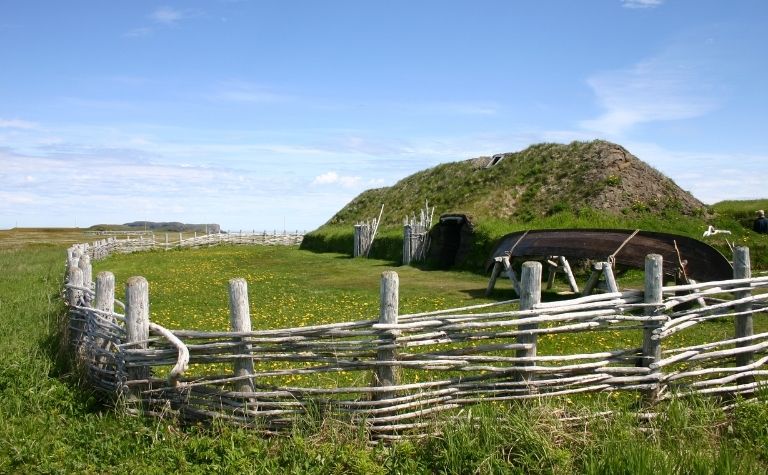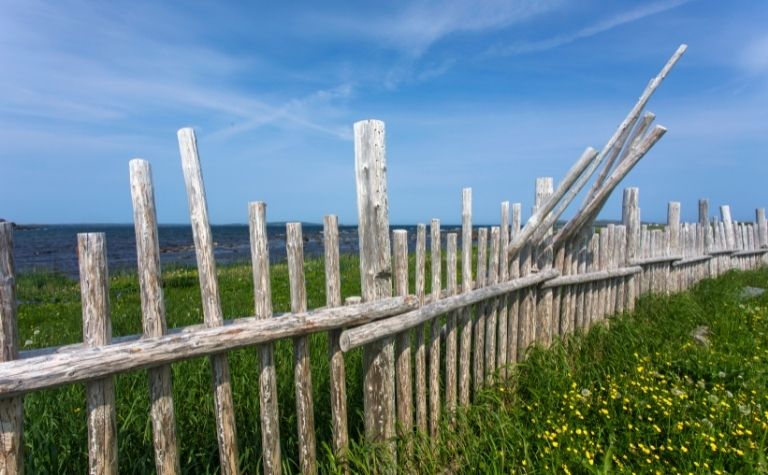Vikings from the Norse colony in Iceland settled parts of what is now Greenland and Northern Newfoundland around the turn of the first millennium of the current era.
But these colonies ultimately failed. Why did the Vikings leave North America?
The Vikings left their North American settlement at L’Anse aux Meadows after only 20 years due to a combination of factors, including a cooling climate, poor relations with natives, and supply problems.
Norse colonies on the east and west coasts of Greenland were abandoned by the mid 14th century A.D.
This article will explore the likely reasons for the failure of the Viking colonies in Vinland and Greenland.
Also see What Did the Vikings Really Look Like? to learn.

What Was the Vikings’ Time in Vinland Like?
Calling the short-lived Norse settlement in modern Newfoundland a “colony” is a bit of an exaggeration.
Conditions in Vinland were spartan and difficult. Archeological evidence and the Norse sagas indicate that fewer than 200 Norsemen lived in Vinland at its peak.
L’Anse aux Meadows, at the North-Western tip of what is now Newfoundland, is the only confirmed Norse site on or near the North American continent other than those on Greenland.
For the Europeans in the late Medieval Era, it was “beyond the end of the world.”
Archeologists aren’t certain if the settlement was occupied continuously or used as a seasonal outpost to support logging and fishing.
Norse settlers from Greenland arrived in North America around the year 1000 A.D.
However, Norse fishermen had likely been casting their lines the waters west of Greenland for over a century at that point. The Norse sagas claim that they found the land abundant in:
- Lumber
- Game
- Fish
- Wild berries, which they misreported as grapes
The abundance of “grapes” gave the land its Norse name, “Vinland.”
Ironically the association with grapes, which require a warmer climate than existed in Newfoundland at the time, caused later scholars and archeologists to search for Vinland much further south.
It was forgotten or overlooked that the Norse of the Vinland period referred to many different fruits as “grapes.”
Archeological excavations at L’Anse aux Meadows indicate that conditions were spartan at best.
The settlement covered 7,991 hectares (19,746.19 acres), or about 31 sq. miles (80.29 sq. km). [1]
It was mostly dedicated to farm fields. Human habitation was small, with no more than eight Nordic turf houses.
Examination of middens (garbage piles) and human waste at L’Anse aux Meadows indicate that the settlers’ diet was primarily grain-based, with a large amount of fish, local game, and local fruits, including North American frost grapes and berries.
There’s no indication that the settlers brought livestock to Vinland.
Also see Did the Vikings Meet Native Americans? to learn.

Did Native Americans Drive Out the Vikings?
Conflict with the Native Americans wasn’t the primary cause of the failure of Viking settlements in modern Canada and Greenland.
However, there’s archeological and oral history evidence of occasional conflict between the natives and the Norse settlers, and these hostilities certainly didn’t help.
Both Norse and Native American oral traditions report contact between the two parties. [2]
The Norse referred to Native Americans as the “Skræling,” a word derived from the old Norse word for “dried skin.” It’s believed the name came from the leather clothing worn by local natives.
Native Americans, specifically the Thule Inuit, report contact with a group called the “Kavdlunait,” a catchall term for foreigners, around the same time.
According to Inuit oral histories, relations between them and the Kavdlunait were mixed.
Sometimes they amicably traded fish and arctic game for iron tools, and sometimes they killed each other on-site.
The Norse Sagas report that the first contact between them and the Skræling in Vinland was hostile.
Shortly after first landing in Vinland, a Viking party led by Thorvald Erikson (Leif’s younger brother) discovered a group of Skræling hiding under a canoe and killed them.
The Skræling retaliated with a much larger war party and killed several Vikings, including Thorvald himself.
The Saga of the Greenlanders reports that the Norse settlers dealt with sporadic raiding from small groups of Skræling throughout their time in Vinland. [3]
At least two significant battles were fought between the parties around the years 1003 and 1010 A.D.
Archeological evidence of contact between the Norse settlers at L’Anse aux Meadows is extremely sparse.
It consists of a single Thule Innuit-style arrowhead embedded in the wall of a log longhouse.
The Vikings had a massive technological advantage over Native Americans, being armed with iron armor and weapons.
But Native Americans had many more people.
At most, there were no more than 200 people at L’Anse aux Meadows at any one time, while the local native population numbered in the thousands.
Also see 10 Famous Vikings from History? to learn.
Did Environmental Conditions Cause the Vikings To Leave?
The abandonment of the Norse settlement at L’Anse aux Meadows can’t be directly attributed to climate change at this time.
But the failure of the Norse colonies in Greenland was likely primarily due to the onset of the “Little Ice Age” in the mid 14th century A.D.
The settlement at L’Anse aux Meadows was abandoned around 20 years after the first settlers arrived.
It’s not known if environmental conditions were related to its collapse.
The main settlement on the west coast of Greenland lasted until the 1350s A.D., and its collapse was primarily due to the cooling climate.
The exact cause of the Little Ice Age has yet to be determined, although poorly timed volcanic eruptions in the Central Pacific region and Iceland are the prime suspects.
Whatever the cause, average temperatures dropped between 6 °C (42.8 °F) and 8 °C (46.4 °F) by the late 1300s A.D.
The cooler climate caused Arctic ice packs to expand and summer sea ice to grow relatively rapidly.
The further south the summer sea ice reached, the more difficult fishing and trade with the wider Norse world became.
Climate change also brought crop failures and severe winter weather to Greenland.
The exact date of the failure of the Viking settlements in Greenland is not known.
Records from the Vatican indicate the last confirmed news from the Norse settlements was received in 1410.
The Papacy discussed dispatching a Bishop to “the country at the end of the world” in 1492, but the expedition never left.
Also see Did the Vikings Ever Fight the Romans? to learn.
What Else Contributed to the Failure of the Vikings in North America?
There was no single cause for the failure of Norse settlements on the North American subcontinent.
Instead, several causes teamed up to drive the Norse back to Europe.
Alongside poor relations with natives and a cooling climate, Norse settlers faced supply problems due to the cooling climate and political strife in the wider Norse world.
It’s difficult to comprehend how isolated the Norse settlements in Greenland and L’Anse aux Meadows were from the rest of the Viking world.
The closest major population center to the Greenland settlements was Iceland. The closest real center of power in the Norse world was Denmark.
At its narrowest, the sea between Greenland and Iceland (Straits of Greenland) is 300 km (186.41 mi) wide.
Viking longships weren’t designed for sailing the open sea but rather following coasts and rowing up rivers.
Even at the height of the Viking Age, reaching Greenland or Newfoundland was dangerous and expensive.
Due to the distance and difficulty, the Norse trade routes that made up the main supply lines for the distant settlements were barely profitable.
And when the climate began to deteriorate in the late 1200s, those supply lines snapped.
Farmland in Greenland was marginal at best. There was a thin 50 km (31.07 mi) band of land between the sea and the ice pack, and most of that was either too mountainous or covered in forests.
And due to overgrazing and poor land management, most of the topsoil had washed away by the mid-1300s A.D.
With the climate rapidly becoming too cool to farm and traders traveling to more accessible ports elsewhere in the Viking world, the Norse settlements in Greenland faced starvation and increasing isolation.
The Western settlement was abandoned by 1360, and the Eastern settlement was last heard from in 1410.
Another cause of the trade disruption which helped cripple the more distant Viking settlements was political strife back in the Norse homeland.
For most of the Viking Age, the Norse homelands on the Scandinavian peninsula were controlled by a disorganized melange of petty chiefdoms.
But beginning after the introduction of Christianity in the early 9th century A.D., a succession of petty kings made more and more progress toward imposing order on the Norse world.
The Viking Age is commonly accepted to have ended in 1066 with the victory of William the Conqueror at the Battle of Hastings.
The Norman conquest effectively removed the British Isles from the Norse world. It also caused kings back in Scandinavia to turn their attention eastward.
By the end of the 13th century A.D., Norse lands were largely divided into kingdoms with similar borders to the modern Nordic states.
Norse traders were more interested in the highly profitable trade routes between the Byzantine Empire to the South and Swedish-controlled Russia to the East.
The main centers of power simply forgot about the North American colonies.
Conclusion
The failure of Norse settlement in North America was primarily due to the cooling climate and disruption of trade with the Norse homelands.
